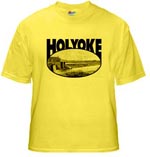by Laurel | March 6th, 2013
31 May 1903
Whiting Street and His Connection With River Boating.
The times of Whiting Street are inseparably connected with the old boating days on the Connecticut, when the flat bottomed boats, laden with their cargoes of flour, tea, spices, wares of all kinds — in short, a general miscellaneous cargo as would fit out a general country store, sailed up the river from Hartford or beyond to “Jed” Day’s landing, which was then situated almost directly opposite where the big sandbank in South Holyoke on the Springfield Road is located. Waiting for a south wind, these boats would start from the Connecticut emporium, and, having completed their journey, return laden with lumber and farm produce or whatever the region about land had to furnish in the way of exchange. The channel through which the boats passed up above Holyoke is still plainly marked as low water. At the upper end of the rapids was located a big wheel, arranged so that it could be lowered into the water, and, run by the current, would wind up a rope on a drum to which it was attached and thus pull up the heavy boats against wind and tide. There was a regularly organized company of Holyoke people, including several of the Elys, in which Whiting Street became interested. His bother Alpheus had a share, but the first venture in which he had a part after he had invested did not prove a very paying one. They brought up on that trip some earthenware, and the sale of it was slow. Alpheus repented of his investment and expressed to Whiting his regret that he had gone in. Whiting thereupon ad him an offer for his share, and it was promptly accepted. Alpheus lived to see much money to be made in the business that he had entered upon, but renounced.
Doubtless the conservatism o the day and of the district had much to do with his brother’s withdrawal. Yet it is not difficult to picture the distrust with which the farming men at the onset looked upon the river business. Seth, leaning up against the fence that separated his “medder lot” from his neighbor, Abiram, may have discussed the situation with him and deprecated the folly of abandoning the well-beaten paths for the new.
“Spose Whiting Street sorter thinks that he’s going to make his ‘tarnal fortune shoving those old mud scows up and down the river,” Seth may have remarked.
“Mebbe he will and mebbe he won’t,” would reply Abiram sententiously; “but as for me, give me good rich sile and regular crops.”
And the two old worthies would shake their heads and sigh over the folly that saw in river freighting a reward equal to that which was the portion of the toilers on the rich farms that bordered the banks of the “Long River.”
It was in this river business that Whiting Street made the beginnings of his fortune, so that when the Connecticut River railroad was opened in 1846 and the freightage by river ceased, he was able to invest large sums for those days in various enterprises such as the Parsons paper company and Hadley Falls bank, and enabled him to leave $113,500 for charitable purposes while generously remembering his surviving relatives.
Whiting Street was born in Wallingford, Connecticut in 1790, 10 years earlier than Alpheus, and the oldest of a family of five. Men acquainted with all of them say, with no disrespect to his brothers and sisters, Whiting was far ahead of them mentally, and none of them possessed his keen business instincts. Even when a young man, he displayed such a talent for earning and accumulating money as to attract attention. His first start was in the boating business, then in its infancy. the date of it is lost, but the boating business ceased in 1846 and was at its height in the preceding 10 or 15 years. Stephen Bemis of Chicopee, writing in 1827, makes a complaint of the delay in forwarding freight from “Jed Day’s landing,” and other papers left by him show that he had to do with the boating business from that date until several years later. And Pelatiah Ely wrote to Whiting Street of arrival time obtaining some freight at Hartford belonging to the line. The letter of Mr. Bemis was addressed to Messrs. Strong, Ely & Co. and was as follows:
Gentlemen, I have to complain to you (besides the delay of getting the wood, which lays damaging on the banks) of my goods not being landed here after they get up. A parcel of stoneware has laid at Jed Day’s landing for a week — notwithstanding I gave notice to Mr. Street that it was mine — and one if not two boats have gone down and not taken it. Also a bundle of ax advertisements which I want, as much as the axes have never been left, also numerous inspection bills of wood. I am certainly willing to put up with any reasonable inconvenience, especially when occasioned by bad winds ad weather — but when too much business and the necessary hurry attending it is the cause — when you are making the money, which occasions my losing had not I ought to be made whole? I hope you will yet be able to boat the wood, although it is so late in the season that I hardly expect it.
I am yours, etc.,
Stephen C. Bemis.
It is evident from the letter that complaints and other matters were referred to Mr. Street as early as 1827 for adjudication. He became quite prominent in the business and acted as agent, and was one of the leading spirits in the enterprise. How much he accumulated by his river business is not known, but on the founding of the Parsons Paper Company, in 1852, he was able to put in $10,000, and it is likely that this was only a part of his savings at this time. The boating business grew to large proportions the next score of years and cannot be treated in the limits of this article. Yet it is well to bear in mind that it was this business that developed Whiting Street’s business acumen as well as land the foundations of his fortune.
Adapted from The Springfield Republican.









